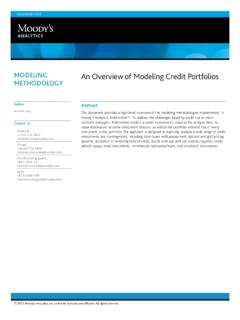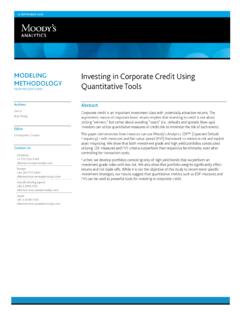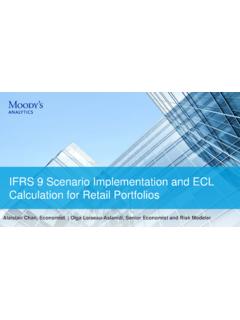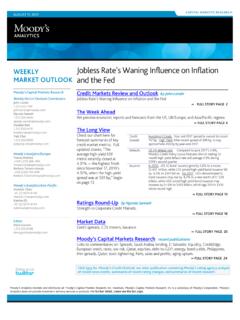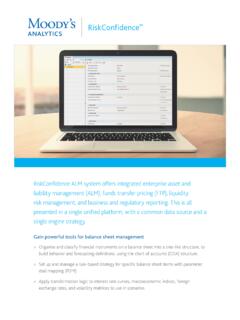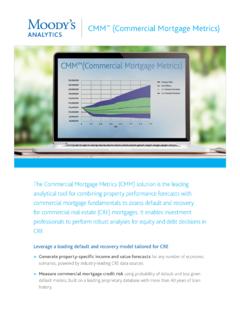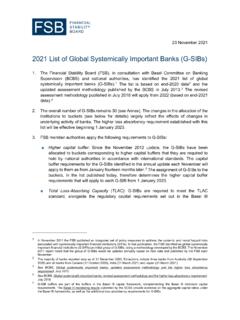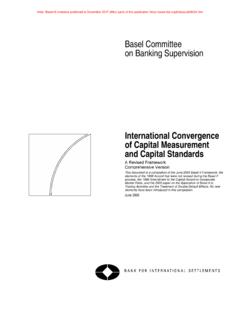Transcription of Regulation Guide: An Introduction - Moody's Analytics
1 Regulation guide : An Introduction Essential insight serving global financial markets 2011 Moody s Analytics , Inc. and/or its licensors and affiliates. All rights regulations : an introductory frameworkThe basel Commitee s RoleMost of the global banking and insurance regulations have been initiated or inspired by the work of the basel Committee on Banking Supervision and its so-called basel regulations . Read this section to understand what the basel Committee is, what it aims to achieve, and its impact on the regulations your clients and prospects have to comply with basel Committee on Banking Supervision (BCBS) was established in 1974 in response to a period of major disruptions in the international currency and banking markets (1971 collapse of the Bretton Woods Accord, 1973 stock market crash, 1974 oil price shock).
2 BCBS members are drawn from 27 countries which are represented by their central banks and financial regulators. The Committee aims to enhance understanding of key supervisory issues and improve the quality of banking supervision worldwide. It achieves this partly through its role as a forum for cooperation and information sharing for national supervisors, and partly by issuing guidelines and standards. The Committee does not have formal supranational authority and its standards do not have legal force. Rather, it is expected that national supervisors incorporate these standards into their regulations , with which regulated institutions then have to comply.
3 basel regulations are also adopted by non-member BCBS countries that see benefits both in the regulations themselves and also in being associated with conformity with basel standards. The BCBS actively encourages contact and cooperation between its members and other banking supervisors. Whilst at different stages of implementation, many countries are now applying basel today s global business environment, international coordination has become increasingly important. Application of the same standards across countries allows for consistent comparisons by investors and creditors, thereby supporting market confidence. Whilst this can be particularly relevant for banks in emerging markets, the recent sub-prime and sovereign crises have highlighted the dependence of some of the largest industrialised economies on their banking systems and thus the importance of global BCBS is best known for its international standards on capital adequacy which have evolved from basel I, issued in 1988, through basel II issued in 2004, to its latest enhancements issued in 2010, commonly called basel III.
4 Full compliance with basel III is required by 1 January 2019. Dec 1992 Official deadline for basel I complianceDec 1996 basel I amendment for market risk Jul 2009 basel II adjustments for securitisation and trading book instruments (also called basel )Jan 2013 Current official date for basel III implementationNov 2010 G20 endorses BCBS basel III proposalsDec 2010 basel III is publishedDec 2009 Proposed basel II adjustments for enhanced capital adequacy rules, liquidity risk management and systemic risk monitoring (also called basel III)Jun 2004 basel II is publishedMay 2009 basel Committee publishes Principles for sound stress testing practicesDec 2011 Official deadline for basel 2011 basel III observation period beginsDec 2006 Official deadline for basel II complianceJan 2019 Current official deadline for basel III complianceJul 1988 basel I is publishedRegulation ImplementedRegulation IssuedChart 1: History of basel regulations : a 2011 Moody s Analytics , Inc.
5 And/or its licensors and affiliates. All rights Minimum Capital Adequacy RatioThrough most of its regulatory guidelines and requirements, the BCBS aims to ensure that banks hold sufficient capital to meet their current and expected liabilities. To help achieve this, it has introduced a minimum capital adequacy ratio which measures the level of capital required according to the level of risks the bank takes. In this ratio the assets are weighted according to the level of risk they carry. For example, a loan secured by a letter of credit would be weighted riskier than a mortgage loan that is secured with collateral. This minimum ratio forms the basis for the capital requirements promoted in basel II.
6 Most subsequent enhancements to basel II relate to the composition of this ratio, as the regulators try to adjust capital requirements to better capture banking institutions business models, product innovation and market evolution. It can help to think of these enhancements in the following way: Enhancements to the ratio when the minimum amount of capital that the bank is required to hold increases or decreases (for example from 8% in basel II to in basel III); Enhancements to the numerator when the definition of the capital changes (as in basel where hybrid capital is no longer considered eligible as regulatory capital); Enhancements to the denominator when the weighting or the process of assigning a risk weighting to assets evolves ( in basel III).
7 basel regulations PillarsBasel Regulation has evolved to comprise three pillars concerned with minimum capital requirements (Pillar 1), supervisory review (Pillar 2), and market discipline ( pillar 3 ). Today, the Regulation applies to credit risk, market risk, operational risk and liquidity risk. Capital by itself does not guarantee a bank s financial security. As highlighted in the most recent global financial crisis, a bank also needs to be able to meet its obligations in a timely manner. The most recent iteration of basel Regulation , basel III, thus introduced liquidity ratios. With this enhancement, the BCBS objective is to ensure that banks hold a sufficient amount of assets that can be easily and quickly converted to cash to meet liabilities over both short- and longer-term periods.
8 basel banking regulations are not limited to quantitative requirements. In large part, basel regulations promote the implementation of risk management best practice within banks. The ICAAP (internal capital adequacy assessment process) requirements under Pillar 2 and the more recent stress-testing guidelines are good examples of how the BCBS aims to achieve this objective. Whilst much of the basel Committee s focus has historically been on micro prudential supervision, the recent global financial crisis has alerted supervisors of the need to work together more closely and to facilitate the management of systemic CARR atio of Capital to RWAN umerator the CapitalDenominator the RWAM inimal Capital Adequacy Ratio (CAR) Risk Weighted AssetsCapital-AdjustmentsEssential insight serving global financial markets 2011 Moody s Analytics , Inc.
9 And/or its licensors and affiliates. All rights II regulations : an Introduction basel II guidelines were originally published in 2004 with the objective of creating standards and regulations around how much capital banks must hold. The Regulation is divided into three pillars concerned with minimum capital requirements, supervisory review and market discipline. Pillar 1: Measure and report minimum regulatory capital requirementsUnder Pillar 1, firms must calculate minimum regulatory capital for credit, market and operational risk. Credit risk is the risk associated with bank s main assets, that a counterparty fails to repay the full loan.
10 It is present in all banking book assets and off-balance sheet products as well as counterparty credit risk for banking and trading book derivatives and repos. Market risk is the risk of losses (on- and off-balance sheet) due a decrease in the value of investments. It applies to all trading book products. Operational risk is the risk of loss resulting from inadequate or failed internal processes, people and systems, or from external II mostly focuses on Credit Risk and Operational Risk as Market Risk was addressed in basel I. Regulatory capital is calculated using the minimum capital adequacy ratio (CAR) which determines the minimum capital required to cover unexpected l osses.



